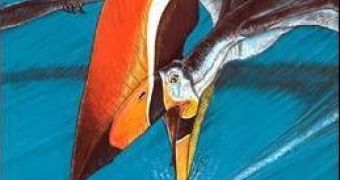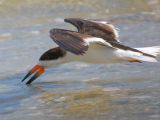The skies during the dinosaur era were not dominated by birds, like it happens in our times, but by huge prehistoric hairy flying reptiles called pterosaurs. Many of them were fish-eaters and are often pictured as skimming along the surface of water while flying with their mouths open, fishing the way modern skimmers fish: when they stumble on a fish while skimming, the fish is captured and eaten.
But new biomechanical research shows this was impossible: any pterosaur would have crashed in the water if it tried this. Pterosaurs ("winged lizards") were as related to dinosaurs as they were to modern day lizards and snakes. They were the first vertebrates to develop active flight, about 220 million years ago. They included the largest ever flying animals, that had over 40 feet (13 m) across in wingspan.
Their diet remains largely a puzzle. Some researchers showed similarities between the pterosaurs' jaws and the beak of the modern birds called skimmers (3 tropical species in the genus Rynchops).
That's why a team led by biomechanist Stuart Humphries at the University of Sheffield in England made experiments using life-sized models of pterosaur jaws and modern skimmers, dragged through water flumes. The tests showed that pterosaurs weighing over 2 pounds or so (0.9 kilograms) could not skim, as their bills faced high drag forces when dipped into the water, almost like oars.
The extremely thin bill of modern skimmers is extremely well-fitted to decrease drag, being 2 mm wide, while the "skimmer" pterosaurs had 0.5-1.5 inch (1.5-3 cm) wide jaws.
In a skimming attempt, pterosaurs "may well have been able to muster up enough energy to stop themselves falling out of the sky and to remove their lower jaws from the water, but anything more than a couple of seconds could result in a tumble. Even smaller pterosaurs could not have skimmed, lacking the right necks and skulls for such a trick," said Humphries.
Rynchops skimmers had also thin skulls, large jaw muscles, reinforced joints and strong, flexible necks, anatomical features not found in "skimming" pterosaurs.
"The most probable remaining option is that they fed by plucking food from the water surface in a similar way to gulls or albatrosses today. There is evidence that some fed on hard-shelled animals, some by picking or pecking in similar ways to birds." said Humphries.
Still, one species of pterosaur, Thalassodromeus sethi, had thin jaws, possible strong neck muscles and a horny extension at the tip of the jaw that could have decreased the water, signaled paleontologist Alexander Kellner at the Federal University of Rio de Janeiro. "I welcome this kind of study and, despite my criticisms, am very happy that other scientists or students have a look at fossils from a different perspective," Kellner said.

 14 DAY TRIAL //
14 DAY TRIAL // 
